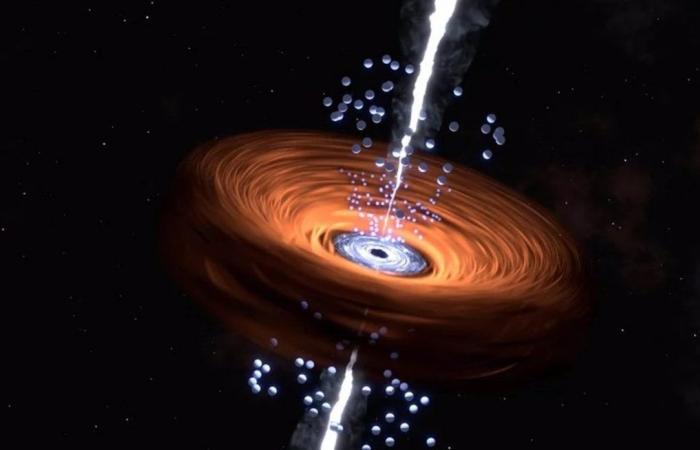Artist’s impression of the bright central region of a quasar, an active galaxy. – T. MÜLLER / MPIA
MADRID, June 24 (EUROPA PRESS) –
The James Webb Space Telescope has observed a galaxy in the youngest stage of the universe that, however, exhibits a black hole at its center that It already weighed a billion solar masses.
Looking back, it became clear that the light from the galaxy called J1120+0641 took almost as long to reach Earth as the universe has taken to develop to the present day.
Analysis of the material in the vicinity of the black hole would supposedly reveal a particularly efficient feeding mechanism, but astronomers have found nothing special. “This result could mean that astrophysicists understand less about the development of galaxies than they thought. And yet, they are not at all disappointing,” according to a statement of the Max Planck Institute on research, published in Nature Astronomy.
The observations were carried out in January 2023, during the first cycle of JWST observations, and lasted approximately two and a half hours. They constitute the first mid-infrared study of a quasar in the cosmic dawn period, just 770 million years after the Big Bang (redshift z=7). The information comes not from an image, but from a spectrum: the rainbow-like decomposition of the object’s light into components of different wavelengths.
The general shape of the mid-infrared (“continuous”) spectrum encodes the properties of a large torus of dust surrounding the accretion disk in typical quasars. This torus helps guide matter toward the accretion disk, “feeding” the black hole. The bad news for those whose preferred solution to massive early black holes lies in alternative rapid modes of growth: the torus, and by extension the feeding mechanism in this very primitive quasar, appear to be the same as in its more modern counterparts. The only difference is one that no rapid growth model of early quasars predicted: a slightly higher powder temperatureabout a hundred Kelvin warmer than the 1300 K found for the hottest dust in less distant quasars.
The shorter wavelength part of the spectrum, dominated by emissions from the accretion disk itself, shows that for us, as distant observers, The quasar’s light is not dimmed by more dust than usual. Arguments that perhaps we are simply overestimating the masses of early black holes due to extra dust are also not the solution.
The quasar’s broad-line region, where gas clumps orbit the black hole at speeds close to the speed of light, allowing the mass of the black hole and the density and ionization of the surrounding matter to be inferred, also appears normal. For almost all the properties that can be deduced from the spectrum, J1120+0641 is no different from quasars of later times.
“Overall, the new observations only add to the mystery: the first quasars were surprisingly normal. No matter what wavelengths we observe them at, quasars are almost identical at all times in the Universe,” says Dr. Sarah Bosman, postdoctoral researcher at the Max Planck Institute for Radio Astronomy and main author of the study. Not only the supermassive black holes themselves, but also their feeding mechanisms were apparently already completely “mature” when the Universe was just 5% of its current age.
By ruling out a number of alternative solutions, the results strongly support the idea that supermassive black holes started with considerable masses from the beginning, in astronomical jargon: that they are “primordial” or “seed-big.” Supermassive black holes did not form from the remains of primitive stars and then grew massively very quickly. They must have formed early with initial masses of at least one hundred thousand solar masses, presumably through the collapse of early massive gas clouds.






